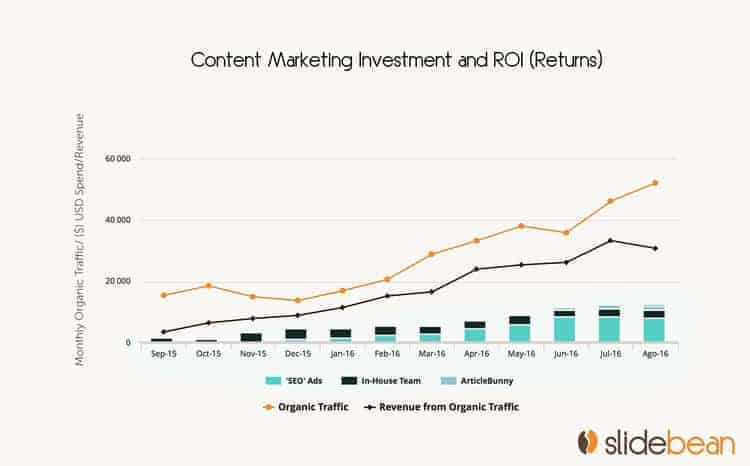Too many people simply “do content marketing.”
There’s no strategy behind it. It’s not tied into the business in any real sense. It’s just an item on the to-do list that they keep doing each and every week, without ever getting much from it.
And if that’s what you’re after–just something to publish on your blog–there are plenty of companies that would love to take your money and hand you some words to publish.
But, if your content marketing isn’t aligned with your high-level business objectives, then why are you doing it?
You might as well light that money on fire–seriously.
Let’s be real. If you’re investing money and time and energy into content marketing, it’s not because you want content. Content is just a means to an end.
You want results.
You want something real and tangible for your business–brand awareness, leads, traffic, users, etc.

Simon Sinek’s famous “golden circles” illustrate how you build a strategy by starting with “why” you’re doing it (specific goals) and ending with “what” you’ll actually be doing (tactics).
(Image source: Invitro)
And your content marketing should be working to help make that happen. But you have to first align your content marketing with the things that you actually want to accomplish. You can’t just be after vanity metrics like “social engagement” or pageviews unless those are directly correlated to your real goals–the ones that matter to your business.
In this post, we’ll do a walkthrough on how you can align your content marketing strategy with your real, tangible, and valuable business goals so you can actually create value with content.
In practice: Driving business results with content
Before we jump into the step-by-step part of this article, I want to show some examples of what it looks like to align content marketing with business objectives.
This is when, rather than focusing on just metrics, you look at the overall picture and tie it back to your business and what will matter at the end of the day.
Let’s look at some examples.
SlideBean drove $200,000 in revenue in one year
The folks at SlideBean have published a tell-all case study of how they used content marketing as the main growth driver for their SaaS startup.
In their case study, they show how their efforts drove traffic to their blog. They focused on specific keywords that they wanted to drive organic traffic (like “pitch deck”) and then converting those visitors into users and customers.
But, they took it further and showed how they were able to use that traffic to generate real dollars for their business. In just over a year, they grew to $200,000 in revenue through their content efforts.

Source: Slidebean.com
In other words, they started with their business goal (revenue/users), defined metrics for success (organic rankings/traffic), and then specified tactics they would use to generate results (evergreen content, link building, etc).
Revenue -> Organic visibility/traffic -> Evergreen content
They share a lot of details about their strategy, including their investment in content marketing, and how they used that content to generate real business results.
Groove built a $5mm/year business entirely on content marketing
Another often-cited case study of content marketing brilliance is Groove, a help-desk software company.
Amazingly, they have built an entire business only on content marketing. No ads. No other kinds of marketing.
How did they do it? Well, they started by telling a very compelling story–and
They began with users/revenue as their goal, identified their key metrics as being email signups and app trials, and then developed a tactical plan for building their email list and funneling their readers into users and trial sign ups.
As you can tell–it’s worked. Like, insanely well.

Source: Groovehq.com
Groove is on their way to reaching $500,000 in MRR and they’re still going strong.
Fisher Tank generated $3.2 million in sales leads
In case you’re wondering if this works for other kinds of companies, this example comes from one of the least-likely content marketing industries in the world.
Fisher Tank creates welded steel tanks–or something.
It’s not exactly the sexiest thing in the world. But, with the right strategy, rooted in business objectives and anchored by metrics, just about any industry can make this process work.

Source: Wiedert.com
They list a lot of fancy metrics here–but don’t worry about that. Look at the bottom line. $3.2 million in sales opportunities is killer.
The point of these examples is really one thing: To show that content marketing can drive real, serious, and measurable business objectives.
But it doesn’t happen on its own.
Anyone investing in content marketing needs to start–from the very beginning–thinking about how they want to generate real results. Then, work that process backward to drive strategy.
In the rest of this article, I’ll explain how you can go about this process.
Step 1: Define and prioritize your business goals
If you’re going to invest in content marketing, it’s (hopefully) because you want to gain something tangible for your business.
To start, you should make a list of all of the relevant business objectives that you’re trying to achieve through content marketing.
These could be things like:
- Increase traffic
- Drive event registrations
- Generate more users
- Grow organic (free) traffic
- Improve brand awareness
Be cognizant of which goals content marketing can have a direct impact on. If you have a direct sales process, then content marketing can be an effective tool for generating traffic and leads, but it probably won’t directly lead to higher revenue per engagement (that’s probably on your sales team).
Identify 3-5 primary objectives that you want to accomplish, then prioritize those in order of importance to your company.
Let’s take the example of a SaaS company. They may identify their three primary goals (in order of importance) as:
- Generate trial users
- Grow email subscriptions
- Increase organic traffic
Got it? Good.
Now we’ve got some top-level direction about what we’re trying to get out of this whole thing.
But there’s more work to do.
Step 2: Understand your metrics
Having clear business goals is an important first step, but ultimately these goals need to be translated into metrics that can be measured and tracked over time.
Business Goals -> Metrics
Some goals–like generating leads or increasing organic traffic–are straightforward enough to track directly. You can simply measure the number of leads that come in from your site or the amount of search traffic you generate and then monitor how it changes as you publish new content.
Other metrics may be less direct.
Things like brand awareness are often measured using a proxy metric like branded search traffic, direct traffic to the homepage, or some combination of these. If you want to increase leads or sales, then you might measure both leads attributed directly to content marketing activity and some measurement of their rate of conversion into revenue.
Whatever the case, you need to identify specific metrics (KPIs) that you’ll be measuring directly as a way to gauge the effectiveness of your content on driving your top-level business objectives.
Together, these metrics will give you a view on how effective your efforts are.
Let’s return to our SaaS example and identify metrics based on our business objectives:
| Business Goal | Metric(s) |
| Generate trial users |
|
| Grow email subscriptions |
|
| Increase organic traffic |
|
As you can see, we have identified some specific, measurable KPIs that correlate to each of our stated business objectives.
When you’re identifying metrics, you should focus not just on the baseline measurements, but also on specific segments and attribution data that needs to be considered as well.
For example, rather than using all sign ups as a metric, you should segment to only include signups that originated through your content marketing efforts (e.g., landing page on the blog or came in through organic search, etc).
This is an important distinction.
Metrics and data are great–but without proper consideration and careful planning in advance, the numbers can be misleading or not reflect what you’re really trying to measure.
Once you hammer down some metrics that make sense, the next step is to consider how you’ll actually impact those numbers. If you want to increase your organic search traffic, how will you do that?
This requires specific tactics.
Step 3: Specify your tactics
We began this process by identifying our end goals–in business terms. Then, we backed into specific metrics that would give us more precision over what we were really trying to do with our content marketing and how we would measure success.
Now, we need to identify particular activities that need to happen–the means to the ends.
Metrics -> Tactics
If your business goals are properly aligned with relevant metrics, then your content marketing strategy can be built around the goal of improving the metrics that you identified.
You have clear numbers that you’ll be measuring for impact and from that, you can identify specific tactics as part of your plan. Each tactic should be aligned with the metrics that you have identified.
If you want to increase your subscriptions, how will you use content marketing to do that? You’ll take tactical steps, like implementing a call to action or a subscription pop up.
Together, these tactics become a plan.
Some aspects are one-time projects. Others will be ongoing activities.
Let’s jump back to our trusty table that has outlined our goals and metrics. We’ll add a new column this time, where we’ll list specific tactics that will be aimed at helping to achieve each specific goal.
| Business Goal | Metric(s) | Tactics |
| Generate trial users |
|
|
| Grow email subscriptions |
|
|
| Increase organic traffic |
|
|
For each goal, you should identify 1-3 metrics, and for each set of metrics, you’ll want to identify at least 1 targeted tactic.
This becomes the basis for your strategy, essentially lining up your specific tactical steps with your metrics and then rolling those metrics into a measurable business goal.
Congratulations. You have the bones for a legitimate content marketing strategy that is specifically aligned with your real business goals.
After you’ve outlined each of these components, you now have a framework to move forward.
Step 4: Tag and track
Writing it all down provides the framework for how we’ll go about the actual process.
But there’s still work to do. Most notably, there needs to be the right technology and tracking in place to make sure that you can clearly and accurately measure and attribute the data you need.
You can do most of your tracking through Google Analytics, but you may need to configure some tools to make sure that you capture the data you need, based on the metrics that you identified.
You may also want to create customized reporting to measure specific metrics over time.
Google Analytics goals/funnels
Create goals and/or funnels for specific actions that you want people to take on your website (sign up, etc). This will allow you to run reports that show you the traffic sources, landing pages, etc that have the highest conversion rates.
Here’s a nice tutorial that will help you if you’re not clear on creating goals.
Customized reports
Take some time to configure customized reports in Google Analytics that will help you quickly measure the metrics you’re monitoring.
Link tracking
If you’re hoping to measure the impact of specific channels, you’ll want to use link tracking. This is pretty straightforward, but it means you should take some time to setup a consistent taxonomy that you’ll use on all of your tracking codes.
Here’s a comprehensive guide to using the Google URL builder.
Keyword ranking
If you one of your goals is improving your search traffic or ranking for specific keywords, you’ll want to use a tool like Moz or Ahrefs to track your ranking for specific keywords.
Backlinks and authority tracking
You may also want to track authority to your domain by monitoring backlinks. Again, Moz or Ahrefs are both useful tools for this kind of tracking.
Step 5: Measure and learn
Setting up everything is just the start.
No matter how much planning or analysis you do, ultimately the proof of what works and what doesn’t will be found in the execution.
And this is really one of the most important parts of this process–keeping it going.
This should be an ongoing process of evaluation and learning, with you or your team using data to guide decision making, not only at the tactical level (which tactics are having the biggest impact on your specified metrics), but also on the strategic level (ensuring that the metrics you identified are correctly rolling up into your stated business objectives).
Identify the content and channels that are having the greatest impact.
Then do more of that.
Over time, your strategy will become more precise. You’ll be able to understand the direct relationship between publishing content and its impact on your business. You may even be able to start to forecast your growth based on your content publishing schedule.
As your content marketing becomes an integral part of your core business strategy, it becomes an essential asset–a growth driver–rather than an expense.
Ultimately, content marketing should be an investment that creates value over time.
And it’s an incredibly smart investment–if you do it correctly. But you have to start with your business goals and align your activity with your intended outcomes.
Otherwise, you’re just “doing” content marketing and wasting dollars.